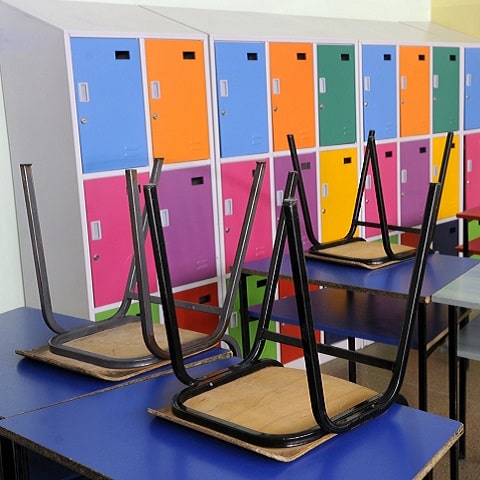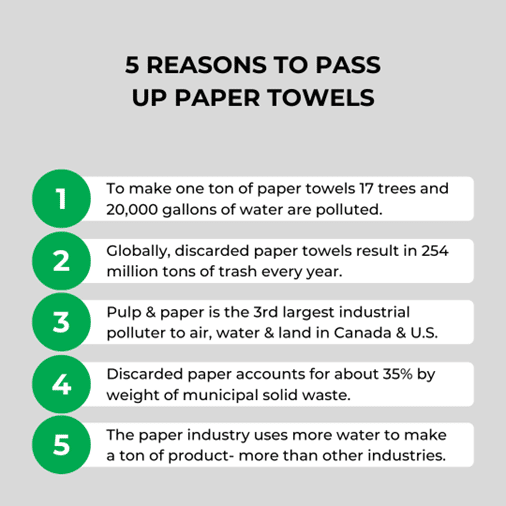
Implementing Commercial Green Cleaning Practices to Support Safer Schools & Universities
It’s not uncommon for a facility’s cleanliness to be defined by visual inspection, but as cleaning professionals, we understand that cleanliness goes much further. From a janitorial perspective, cleanliness has a direct impact on the safety of schools and universities when it comes to protecting occupants from viruses and infections – hazards not detected upon a visual inspection. Additionally, ensuring safe educational environments means maintaining a space where students and staff can thrive.
TheEPA’s Schools Chemical Cleanout Campaign is working to encourage schools to use green cleaning practices to safely clean their classrooms and grounds without the harsh cleaning chemicals that can be harmful to human health and the environment. Green cleaning in schools refers to the use of environmentally friendly and non-toxic cleaning products, methods, and practices to maintain a clean and healthy school environment.
To help lead your facilities towards a healthier and more sustainable learning environment, understanding the value of and adopting commercial green cleaning practices can make a significant impact.
How Dirty are Schools?
The ISSA Clean Standard: K-12 helps schools and other institutional facilities objectively assess the effectiveness of their cleaning processes, contributing to the quality of the indoor environment for the benefit of students and staff. According to ISSA research:
- Nearly 22 million school days are lost annually to the common cold
- <38 million school days are lost each year due to influenza
- Elementary students contract 8 – 10 colds or flu cases each school year
- Teachers average 5.3 absent days a year – teacher absences cost schools more than $25 billion annually
The takeaway? Cleanliness has a far-reaching and costly impact on the health and well-being of educators and students, as well as the schools’ and universities’ bottom lines.
Acknowledging that cleaning and disinfecting play a crucial role in the operational success of the school and the health of its occupants, considering effective commercial green cleaning to replace traditional cleaning methods is a logical next step to further the impact.
What are Green Cleaning Practices
Green cleaning practices involve using environmentally friendly and sustainable methods and products to clean and maintain spaces while minimizing the impact on human health and the environment. Some examples of green cleaning practices include:
- Choosing cleaning products that are labeled as “green,” “eco-friendly,” or “biodegradable”
- Avoiding products containing harsh chemicals, such as chlorine bleach, ammonia, and phosphates
- Opting for refillable containers to reduce plastic waste and avoiding single-use disposable cleaning wipes or paper towels
- Using energy-efficient equipment to reduce energy and water consumption the during cleaning process
- Using water-saving techniques while cleaning
Green cleaning practices often contain fewer volatile organic compounds (VOCs) and harsh chemicals that can negatively affect indoor air quality. Volatile organic compounds are human-made chemicals that are used and produced in the manufacturing of paints, refrigerants, etc. The problem with VOCs is that they are common ground-water contaminants and some may contribute to short- and long-term adverse health effects.
Less chemical usage supports a healthier and more comfortable learning environment, reducing the risk of respiratory issues and allergic reactions. While not everyone reacts the same way, certain agents are known to trigger allergic reactions in some people, including ammonia, bleach, sulfuric acid (often found in drain cleaners) and formaldehyde (found in some air fresheners). Reducing exposure to these harmful chemicals also leads to fewer sick days for both students and staff, resulting in improved attendance rates.
Challenges to Implementing Green Cleaning in Schools
Switching to green cleaning practices is often easier said than done when you consider the factors that go into making an investment – material costs, effectiveness, ease of use and staff training. Given these factors, implementing green cleaning practices in schools and universities can be prone to objections and challenges, such as:
- Perceived Effectiveness: Some individuals may question the efficacy of greener cleaning practices compared to traditional cleaning that may utilize chemical-based cleaners. They might worry that green products won’t disinfect surfaces to the same degree.
- Initial Costs: Commercial green cleaning products and equipment can have a higher upfront cost compared to their traditional counterparts. Schools with tight budget constraints might be concerned about the initial investment required to switch to eco-friendly products and tools. What they may not know though is that while the upfront cost of some green cleaning products might be slightly higher, they often provide long-term savings.
- Resistance to Change: Custodial staff are often resistant to change, especially when it comes to established cleaning routines. Transitioning from traditional cleaning methods to sustainable and/or greener alternatives requires a shift in mindset and habits.
- Training Requirements: Implementing green cleaning practices might necessitate training for janitorial staff to ensure they know how to use the new commercial cleaning tools and products correctly. Training can be time-consuming and may require additional resources.
Addressing these common objections requires clear communication, education, and a well-thought-out transition plan. Demonstrating the effectiveness of green cleaning products, providing training, and sharing information about the benefits can help schools and universities overcome resistance and make a successful shift towards greener cleaning practices.
Greener Alternatives to Traditional Commercial Cleaning Practices
Change can be hard, especially when it involves introducing new cleaning protocols, equipment and employee training. Thankfully, there are some easy-to-use, easy-to-deploy innovative cleaning solutions available to help you more easily make the switch.
- Paper Towel Alternative for Surface Cleaning
Looking at the statistics below, there’s no doubt that the amount of paper wasted when cleaning predominantly with paper towels is neither sustainable nor eco-friendly.

As an alternative, microfiber cleaning cloths are designed to be durable and reusable. They can withstand numerous wash cycles, which means they can be used many times before needing replacement. In contrast, paper towels are single-use and contribute to a significant amount of waste.
Microfiber cloths often require minimal or no cleaning chemicals to effectively clean surfaces, unlike paper towels which necessitate the use of cleaning sprays or solutions, which can have environmental and health impacts. Furthermore, because of the unique microfiber cleaning technology, the cloths are more absorbent and capture and hold dust and allergens more effectively, stopping them from spreading into the air.
- Traditional Outdoor Window Cleaning Alternative
Traditional outdoor window cleaning methods generally incorporate a window washing solution to remove dirt, grime and hard water stains. While the solution may perform its job well, the downside is that the window cleaner and the surrounding environment are both unnecessarily exposed to potentially harsh chemicals as they become airborne or runoff into the ground.
As an alternative, outdoor window washing with pure water technology removes the reliance on chemical-based cleaning solutions. Pure water cleaning utilizes tap water that’s been stripped of its naturally occurring impurities. When the pure water reaches the window, the water immediately wants to try and return to its natural state (one with impurities). To do this, pure water looks for dirt, dust and other particles to which it can adhere. Once the two elements meet, they are bonded together for easy removal during the rinse step of the process.
Not only does a pure water cleaning system leave a spot-free, streak-free surface, but it’s accomplished without any chemical agent.
- Traditional Indoor Window Cleaning Alternative
Traditional indoor window cleaning utilizes a spray bottle and cloth, with the spray bottle cleaner having a mixture of various chemicals, including detergents, solvents, fragrances, and other active ingredients. When sprayed, some cleaners produce a fine mist, while others may emit a more focused stream. The tiny droplets formed during this aerosolization process contain the chemical cleaner and these droplets are small enough to become suspended in the air for a brief period. While some of the emitted droplets settle on the surface, others become airborne and pollute the indoor air quality.
A greener alternative to this traditional cleaning process minimizes chemical usage and better controls the introduction of airborne chemicals without compromising an efficient, effective and safe cleaning experience.
The Unger Stingray is often considered a greener alternative to traditional window cleaning tools due to its design and features that promote sustainability and efficiency. Utilizing a unique water-fed pole system that sprays a controlled amount of water directly onto the glass surface, the targeted water application reduces water wastage. Meanwhile, the microfiber glass cleaning pad removes dirt, grime, and streaks without the need for chemical cleaners.
- Cotton Floor Mop Alternative
A microfiber mop is often considered a greener alternative to a cotton string mop due to its design and features that promote sustainability and efficiency. First of all, microfiber mops require less water for effective cleaning compared to cotton string mops. The absorbent nature of microfiber allows it to pick up dirt and debris with less moisture, reducing water wastage during the cleaning process.
Secondly, these commercial floor mops often require minimal or no cleaning chemicals to effectively clean surfaces. Using less cleaning solution is incredibly important because many floor cleaning products contain chemicals that will eventually go down the drain after use. They are then absorbed into the air, soil, and water. Conventional wet loop mops use $11.55 of cleaning solution per 100 rooms, while microfiber uses $.50 of cleaning solution per 100 rooms.
Using a microfiber mop reduces the use of potentially harmful chemicals that can negatively impact the environment and indoor air quality. And like microfiber cleaning clothes, microfiber floor mopping systems are highly effective at capturing and holding onto dust, allergens and particles before they become airborne, contributing to better indoor air quality.
The Next Step to Greener Cleaning Practices
Some cleaning improvements that bring you closer to a greener way of cleaning may be simple and inexpensive to implement, while others may be more complex and require assistance from experienced commercial cleaning industry professionals. For over 50 years, Unger has assisted schools and universities with the selection of commercial cleaning products with positive environmental attributes. Not only can our innovative cleaning solutions help you clean faster and safer, but also in ways that minimize the environmental impact.
